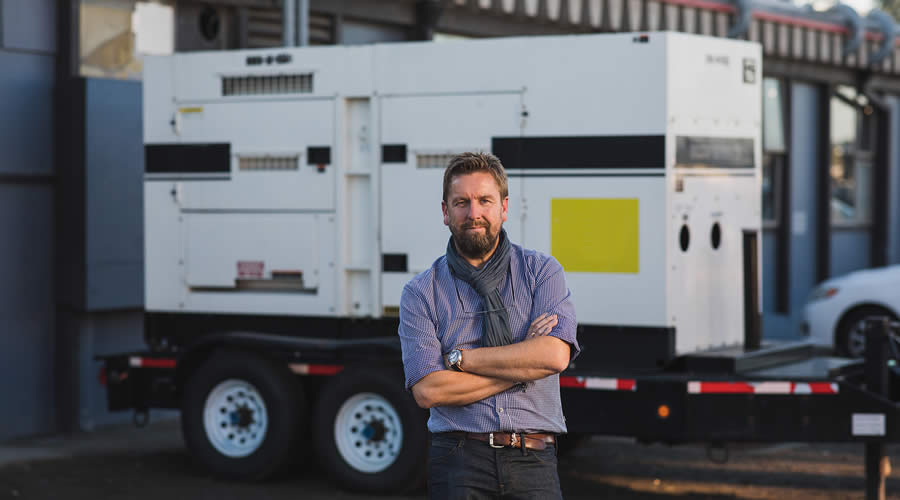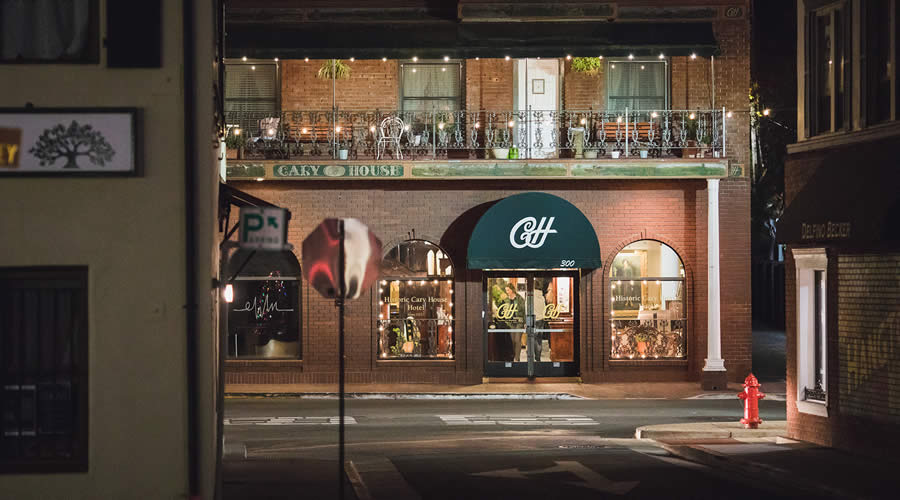The planned power outages that plunged three million Northern Californians into darkness in October threatened countless businesses. While no one yet knows the full economic impact from these Public Safety Power Shutoffs (PSPS), early tallies are sobering.
A Stanford professor estimated just one of the outages, on October 7, could cost small commercial and industrial businesses, which predominate in the rural and suburban blackout zones, $2.4 billion. One Marin County factory that lost power for four days faced a revenue loss of $280,000, while its shift workers faced forfeiting a week’s pay of $700 each.
And those are just the immediate costs. They don’t include what economists are now trying to calculate: the upstream and downstream costs of downtime. For example, a 16-hour power outage at a steel plant affects not only the plant’s revenue and workers’ hourly wages, it impacts upstream suppliers of the steel plant who might not receive a plant order and downstream businesses whose steel shipments are delayed for a day. Unplanned outages at critical facilities like oil refineries can have a wide-ranging impact on the economy, first by reducing production and raising gas prices at the pump, and then by reducing consumer discretionary spending.
The U.S. Department of Energy estimates that yearly power outages cost the economy $150 billion annually. About $27 billion of that loss falls across eight sectors, including manufacturing, financial services, health care, grocery and retail stores, and data centers.
However, energy economists say the engineered outages in California require more study.
“It’s too early to put an accurate estimate on the full economic impact of the Public Safety Power Shutoffs,” says Peter Larsen, a research scientist and deputy group leader in the Electricity Markets and Policy Group at the Lawrence Berkeley National Laboratory.
What’s clear is that without electricity, as many as 100,000 businesses in Northern California were forced to scramble to serve clients, keep their doors open, and reduce damage to their bottom lines. How they did it varies and can provide several case studies in energy resilience and business continuity thinking. Here are three of those stories.

Power panic When a four-day power outage hit Sausalito in late October, Heath Ceramics had to scramble to rent an $8,000-a-month diesel generator (left) to keep its production line running.
Preventing a $280,000 factory debacle
As an experienced manufacturing manager, Neal Beardmore thought he had encountered everything that could trip up a production run. But that was before his team had to wire his factory to a backup generator at 4 a.m., with only car headlights to guide them.
As production director at Heath Ceramics, which designs and creates handcrafted tiles and tableware from a 25,000-square-foot factory in Sausalito, California, Beardmore is responsible for business continuity—keeping his people working and his production line running.
So in late October, when word spread of what would amount to a four-day power outage at his facility, Beardmore did the math and didn’t like what he saw. Shutting down his line, which produces $70,000 of retail ceramic goods a day, could be devastating.
The $280,000 in revenue “would have been lost forever,” he says. And it could have put some 90 employees out of work for a week.

The cost of idle hands Without power for four days, Heath’s workers would have lost $670 in pay. Since many lost power at home, Heath became a place for them to find comfort and friends.
“Our first priority was to look after our staff,” many of whom lost power as well, says Beardmore. Idling the shop’s 50 hourly factory workers would have cost each employee nearly a week’s pay, about $672 each for those four days. “We know that a lot of people are struggling with the costs of living in the Bay Area,” says Beardmore. He also wanted to make sure his employees “had a place to come to for comfort,” for hot water, and a working kitchen.
Beardmore knew if he was going to keep the plant online he was going to have to throw money at the problem. In early October, when he first heard power outages were possible, he rented a 175-kilowatt, portable diesel generator at a cost of $8,000 a month, and an added cost of about $300 in daily diesel fuel usage. He also stocked a pair of 60-gallon drums of diesel fuel as a backup.
Still, when the factory’s power went out on October 29, in the middle of a Saturday night, he and his crew had little idea how much effort it would take to hook up the generator. “On Sunday, at 4 a.m., I was here with my head of engineering, with a pair of car headlights and a cup of coffee, watching him wire up the plant,” says Beardmore.
“It was a pretty tricky changeover,” he says. But four hours later, the factory was up and running.
Beardmore, who has been a ceramics production manager for nearly 20 years, in both the U.S. and his native U.K., has never seen anything like the challenge of managing multi-day blackouts. And with utilities telling the public to expect another decade of them, Beardmore is now spending his days trying to figure out how to maintain his energy resilience and business continuity.

Energy Uncertainty Faced with what utility executives say is the new normal, Neal Beardmore is bracing for more blackouts, and trying to figure out a way to maintain his energy resiliency.
For now, he’s holding onto his $8,000-a-month generator, “just to see us through to the wetter weather” when the wildfire risk dies down and with it the possibility of sustained power outages for millions of residents and businesses. Beardmore and the executives at Heath are even considering the purchase of their own generator, which could cost $100,000.
The company will also spend money relocating its data servers, which are currently housed at the Sausalito facility. The servers support the company’s ecommerce site and went down during the first hours of the blackout, costing additional revenue.
“There are a lot of things we need to look at now,” says Beardmore. “The scale of this disruption is the biggest thing we’ve seen. We need to be ready to keep our business running and our people safe.”
The hotel that refused to close
Apple-picking season is a big deal around Placerville, California, just west of Lake Tahoe in the Sierra foothills and smack in the middle of some of the best antique shopping in the area. It’s an even bigger deal at the city’s landmark hotel, the Historic Cary House Hotel. The 1880s-era, 40-room boutique lodging, with its hand-carved cherry and mahogany wood, has housed everyone from Buffalo Bill and Mark Twain to Lynyrd Skynyrd.
It’s not a hotel that turns people away. So when Josh Salmonson, an assistant manager, got word the local utility planned to shut off his electricity for a few days, he scrambled for a backup power generator. He trekked to and from local hardware stores, but they didn’t have any. He found a Home Depot that still had them in stock, but it was 320 miles away.
Determined to keep his doors open, and his rooms full, Salmonson and his staff began to prepare. Knowing they wouldn’t be able use their laundry room, they washed as many towels, sheets, and pillowcases as they could. To prepare for their reservation system going offline, they printed out paper copies. They made sure the battery-powered locks on the guest room doors could be operated with a manual key.

Paper Trail A days-long power outage forced Josh Salmonson, of the 1880s-era Cary House Hotel in Placerville, Calif., to go back to the old days, registering guests with pen and paper.
He did this even knowing that many guests, aware of the looming blackouts in the area, would either cancel or just not bother to show up. Who wants to stay somewhere, Salmonson says, “if you don’t know if you’ll have hot water or heat.”
When the blackout came and the lights went out, 90 percent of guests didn’t show up. But Salmonson and his staff were there to greet the determined 10 percent who did. They improvised by using the paper invoices and receipts that they’d printed beforehand to register guests and check them out. They made sure everyone had a flashlight and that there were battery-operated lights in the guest-room halls. In the end they managed, but it was by no means enough to keep business revenues where they needed to be.
“Ninety percent [of our expected guests] are not staying when the power’s out,” Salmonson says. “So you can just kind of envision what that’s doing to the business.”
Indeed, with his 40 rooms booking at between $119 and $169 per night, an average day’s loss can add up to more than $5,000. A three-day loss means $15,000, and a figure like that can put a strain on business, and on things like paying the staff and other expenses.
“Ninety percent [of our expected guests] are not staying when the power’s out. So you can just kind of envision what that’s doing to the business.”
Salmonson is now researching a backup generation system that would fit the hotel’s needs. He must also consider some unappealing and painful business choices for the next round of blackouts, which are sure to come. They include scaling back staff hours to make sure he has enough cash to meet his payroll.
“Especially right now, we’re able to make our own revenue and make sure that things don’t fall apart,” he says. What remains are hard choices about the future, about next time there’s a blackout. Does he cut staff hours? Does he dip into his capital funds and splurge for a more expensive generator, one that could cost the hotel up to $50,000 and be able to heat water and keep the lights on in all the rooms, but not powerful enough for things like running the laundry room?
“That conversation,” says Salmonson, “hasn’t taken place yet.”

Hard Choices The management at Cary House Hotel is debating how to handle future blackouts. Among their options: buy an expensive backup generator and fuel or be forced to cut staff hours.
Let them eat ice cream
When he heard Sonoma, California, was on the verge of a days-long power outage, Joe Hencmann stopped making ice cream. His shop, Sweet Scoops Handmade Ice Cream, which he and his wife had plowed their life savings into, is right on the town square, and a blackout, he quickly realized, would cause his inventory to melt and wash out his revenues.
His backup generator produced only enough power for one of his seven freezers, as did a second generator he was able to borrow from a neighbor. Still, after packing the two working freezers as tight as he could, he still had dozens of buckets of ice cream left.
“I knew we were going to lose quite a bit,” Hencmann says.
On Tuesday, when the local utility’s Public Safety Power Shutoff affected his shop, Hencmann did the only thing he knew was an alternative to throwing all his hard work literally down the drain: he gave his ice cream away.
Hencmann started up an ice cream truck he had (it wasn’t even registered, he says), and packed it full. “We just grabbed a bunch of ice cream and just started handing it out all over town,” he says. “We must have handed out 300 scoops of ice cream the first day.”

Sweet Sacrifice When a blackout cut power to their freezers, Ramie and Joe Hencmann refused to see their hard work melt, so they gave away dozens of buckets of their handmade ice cream.
When the power remained off the next day, he again hit the streets on an ice-cream-for-all mission. He gave away a lot, but in the end he couldn’t give it all away.
Including spoilage and the distributed treats, Hencmann says he lost nearly 60 buckets of ice cream. With an average 55 4-ounce scoops in a 3-gallon bucket, and with Hencmann charging $3.50 per single scoop, that could put his loss at more than $10,000. But that’s not a number he even wants to think about or tally.
Hencmann and his wife, Ramie, who started their ice cream shop in 2015, haven’t tried to put a dollar value on their loss. They don’t want it in their minds. And they don’t plan on going to the insurance company for help.
“We’ve talked about it, but we’re not going to claim anything,” Hencmann says. “We don’t want that stress built on us.”
“It hurts, so you just need to try to minimize [that hurt] for the next time—and here we are at the next time.”
Two weeks later, on October 29, the Hencmanns were hit with another round of public safety blackouts. The day before those hit, he says, his family was bracing for what now seemed like the new normal.
“It hurts, so you just need to try to minimize [that hurt] for the next time—and here we are at the next time,” Hencmann says. “So we didn’t make any ice cream yesterday. We’re not making any today or tomorrow. I’m at a period where I have 40 buckets that I just need to try to get out the door and sell.”
Like a lot of California entrepreneurs, one business lesson he learned “is how to scale back,” says Hencmann. And like all those businesspeople, he’s looking ahead to when the rain comes, signaling the end of wildfire season. He might buy a more powerful—and, at $10,000, costlier, diesel generator. It will also require about $117.24 in fuel each day. Or Hencmann might install a large walk-in freezer next summer, when he typically makes capital investments, which could store more ice cream and run on his current generators.
Until then, it wouldn’t be strange to find a man in a truck ambling around downtown Sonoma, feeding the community ice cream—even in the dark.

Fresh Start The Hencmanns probably lost $10,000 in ice cream, but they refuse to dwell on that figure or try to recoup it from their insurer. “We don’t want that stress built on us,” Joe says.
Photos by Drew Bird



